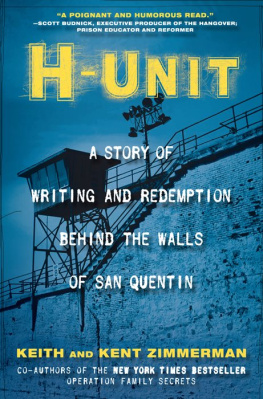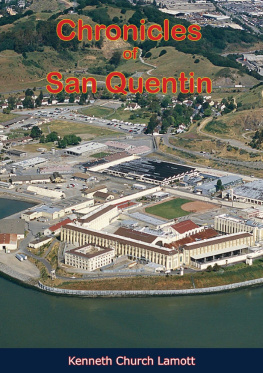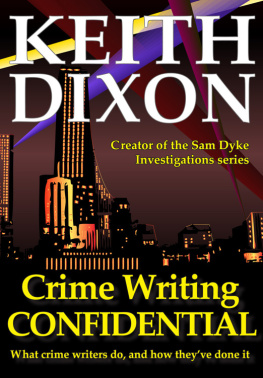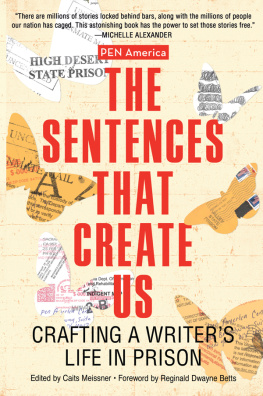TURNER PUBLISHING COMPANY
200 4th Avenue North Suite 950
Nashville, Tennessee 37219
445 Park Avenue 9th Floor
New York, NY 10022
www.turnerpublishing.com
H-Unit: A Story of Writing and Redemption Behind the Walls of San Quentin
Copyright 2012 by Keith and Kent Zimmerman. All rights reserved. This book or any part thereof may not be reproduced or transmitted in any form or by any means, electronic or mechanical, including photocopying, recording, or by any information storage and retrieval system, without permission in writing from the publisher.
Note: All inmate names appearing in this work have been changed, and the writing passages within are author renderings of the kind of prose done in class.
Cover design by Gina Binkley
Book design by Glen Edelstein
Cover image copyright 2012 Ashley Crary
Library of Congress Cataloging-in-Publication Data
Zimmerman, Keith.
H-unit: A story of writing and redemption behind the walls of San Quentin / Keith & Kent Zimmerman.
p. cm.
ISBN 978-1-59652-855-0
1. Prisoners--Education--California--San Quentin. 2. Prisoners--Services for--California--San Quentin. 3. Arts in prison--California--San Quentin. 4. Prisoners as authors--California--San Quentin. 5. Prisoners' writings, American. 6. Zimmerman, Keith. 7. Zimmerman, Kent. 8. California State Prison at San Quentin. I. Zimmerman, Kent. II. Title.
HV8883.3.U52S268 2012
365'.666--dc23
2012014186
Printed in the United States of America
12 13 14 15 16 17 180 9 8 7 6 5 4 3 2 1
The Zimmermen dedicate their work on this book to Doris and Joe.
Love,
Keith and Kent
Acknowledgments
The following people have inspired us and mattered throughout this project: Doris Zimmerman, Gladys Zimmerman, Deborah Zimmerman, Laura Bowman-Salzsieder, Jill Brown, Ashley Crary, Ken Druckerman, Adam Amdur, Todd Bottorff, Diane Gedymin, Christina Huffines, Ann Moller, Steve Ross, Joe Rose, William Watson, Robert McCrary, van Lben Sels/RembeRock Foundation, Mike Ness, Shane Trulin, Steven Rybicki, Bill Hillmann, Brian Murphy, Dinero D the Dynamic "P," Nitin Abraham, Scott Budnick, the CO's at SQSP who watch over us, Ed Preciado, Michael Tolkin, Anne Marino, Gladys Phillips, Philip Bailey, David Mairs, Jordan Harari, Alan Black, Erica Linderholm, Jack Boulware, Naveen and Vin Abraham, Tim Pitt Gordon, Tim Dufore, Jane Ganahl, The Class (book and movie) by Franois Bgaudeau, Gregory Carter, Kevin Whiteley, Sandra & Art Rybicki, Paul McNabb, Rolf Kissman, Richard Walsh, Frank Calabrese, Jr., and the mindful men at H-Unitpast, present and futurewho "program" for a better tomorrow.
Contents
PROLOGUE
Collaborators to the Incorrigibles
For as long as we remember being in California, starting in the summer of 1963 before the November assassination of John F. Kennedy, San Quentin has been a phantom force that lurked in the shadows of our childhoods. We were ten years old when Joe and Doris Zimmerman, our East Coast working class parents, pulled up stakes in East McKeesport, Pennsylvania (the birthplace and home of Andy Warhol) and headed west to the Promised Land in Northern California. "The Twins"that's us, identical, born twenty minutes apartwere about to experience our first major seismic shift in life.
"Kids, we're going on vacation to California," Joe announced over supper with one curious caveat, "but don't tell any of your friends. We might not be coming back."
With $2500 of borrowed cash and a refurbished 1955 Chevy station wagon with a fresh coat of Earl Sheib baby blue paint, and with my father and mother sharing equal turns behind the wheel, we rumbled and sputtered across the United States in search of a new America.
Once we crossed the California border, and settled in Sonoma Countyspecifically Santa Rosa, a stone's throw from the lush Napa Valley wine countryJoe found a "dream job" as a wholesaler for a floor covering and carpeting distributor. Being a salesman on the road meant frequent trips servicing retail stores from Marin County all the way north to the Oregon border. There were lots of weekend day trips to visit aunts and uncles already living in Marin County and the East Bay, which meant frequent jaunts across the Richmond San Rafael Bridge. Whenever we crossed that bridge, our father would announce the presence of San Quentin State Prison. ("I'm gonna drop you kids off there if you don't behave.") It was the first Marin County landmark to greet northbound drivers who exited the bridge on their way back through middling towns like San Rafael, Novato, Petaluma, and then home to Santa Rosa, once dubbed by horticulturist Luther Burbank as "the city designed for living."
Since our very first time driving past its walls, San Quentin State Prison has had the same gold amber beige paint job it dons today, and its arched portals and towers remain visible through the frequent fog. The prison stands next to and is named after the small bayside hamlet nestled in unincorporated Marin County.
Joe's first trip inside the walls of San Quentin was strictly business. He was there to inspect and replace some defective linoleum that had been installed by one of the stores carrying his product line. The sight of San Quentin inmates as "regular Joes" had a huge and instantaneous affect on him. San Quentin State Prison mesmerized Joe. Over the dinner table, he described its thick limestone walls, the multitiered cell blocks, the gigantic mess hall murals, but mainly the men. He marveled to our family how the inmateswhite, black, whateverwere no different than him. Very few of them seemed like the monsters he'd expected from watching George Raft movies. As a result, he had an idea. He would explore the possibility of volunteering at San Quentin, teaching salesmanship, a skill any red-bloodedparolee could use to earn himself an honest living upon release. Ultimately Joe's dream died on the vine. Whether he failed to penetrate the bureaucracy, who knew?
In lieu of Joe's unsuccessful attempt to pursue his dream at the prison, the aura of San Quentin later manifested itself in a more artistic light. In February 1969, we purchased a copy of Johnny Cash at San Quentin the week it was released. The image of a stately silhouetted Johnny at San Quentin bathed in blue light represented common ground between our father and us. Our entire family soon became Cash fans as Johnny snarled, "San Quentin, I hate every inch of you." Cash vinyl got double duty; played loud while the folks were away, played soft after dinner when everyone was together under one roof. The boom-chucka, boom-chucka of Bob Dylan's "Wanted Man," the hopeful gospel harmonies of "Peace in the Valley," but mainly the dual title tracks, both versions of "San Quentin," fit snugly into our family's groove.
Johnny Cash carried huge weight in our clan. He wasn't a longhair, though his hair was thick and swept back past his collar. He loved America, but he had a rebellious streak where he couldn't be spoon fed blind patriotism. Although he had his publicized problems with pills, he didn't glorify drug use. In a Cash song, the cops weren't always the good guys. Outlaws were cool. Native Americans held dignity. He was the singer who wore black "for the poor and beaten down." He did so also for the prisoner, a victim of the times, who paid for his transgressions. He discovered, as we would, that it's possible to simultaneously love and hate a place like a century-and-a-half old prison. "San-Quentin-I-hate-every-inch-of-you" would soon become words to live by.












